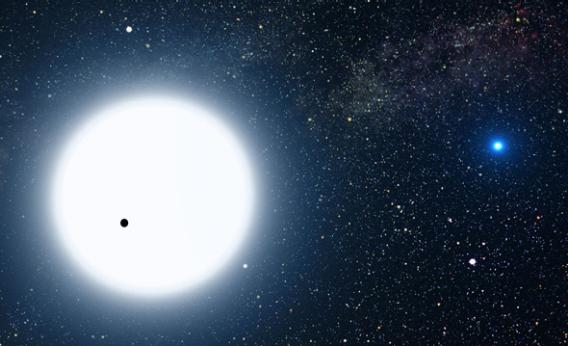Create a free profile to get unlimited access to exclusive videos, sweepstakes, and more!
Twin Planets Found Around Twin Stars

Well, this is interesting: Astronomers looking for exoplanets—alien worlds orbiting other stars—have found a binary system (two stars orbiting each other) where both stars have a single planet orbiting them!
Plenty of circumbinary planets have been found, where the exoplanet orbits both stars at some distance (think Tatooine), but it’s rare to find a binary star where both stars have their own planet (called circumprimary planets).
The binary is called WASP 94AB (the 94th planetary system found by the Wide Angle Search for Planets, where the two individual stars are called A and B). Both stars are classified as F-types, somewhat more massive and hotter than the Sun. They orbit each other at a distance of at least 400 billion kilometers, about 90 times the distance of Neptune from the Sun.
The planets are both “hot Jupiters,” gas giants that orbit their respective host star closely. One of the planets, WASP 94Ab (planets are given lower case letter designations starting at “b”), was discovered because it transits its star, moves directly between us and the star, blocking a wee bit of its light. Knowing how big the star is, we can determine how big the planet is by how much light it blocks. In this case, it’s 1.7 times wider than Jupiter.
We can also get its mass, because as it orbits the star it tugs on it, and we can measure that effect. The planet’s mass, interestingly, is only about 0.45 times Jupiter’s. So it’s less massive, but much larger than Jupiter. Why?
Heat. It orbits the star every four days, which means it’s very close to this inferno. The planet absorbs that heat, and its atmosphere puffs up, making it much larger than you’d expect.
The other planet, WASP 94Bb, was discovered by accident! Although it does not transit the star, it still tugs on it, and this effect was discovered when the astronomers serendipitously observed WASP 94B at the same time as WASP 94A. They found the planet’s mass to be about 0.6 times Jupiter’s (the size can’t be found because there’s no transit). It takes only two days to orbit the star.
What’s very interesting, though, is that these planets exist at all! We know planets this massive can’t form this close in to stars; it’s too hot for planets to be able to gather enough material to grow that big. The current thinking is that they form much farther out and migrate inward toward the star. When they form, there’s a disk of material around the star called the protoplanetary disk, and plowing through this material drops the big planet down toward the star, eventually stopping when the disk peters out close to the star.
However, there’s more going on with the WASP 94 planets. For one, careful measurements of the first planet show it orbits the star in the wrong direction, opposite to the star’s spin! This retrograde motion, as it’s called, can’t be due to simple migration inward; something else must have kicked the planet in some way to get it moving the opposite direction.
For another, the other planet doesn’t transit, meaning its orbital plane is tilted quite a bit from the first planet. The two stars almost certainly formed together, and have very similar properties, so the disks that formed the planets should be similar. You’d expect both disks would have aligned with the orbital plane of the two stars themselves. But at least one of the planets is out of whack.
It’s possible these anomalies are due to the mutual gravitational influences of the stars, one tugging on the disk of the other. But they’re very widely separated, so this is unlikely (though not impossible). Perhaps WASP 94A has or had other planets that interacted with the planet 94Ab, sending it into a weird orbit.
Whatever happened here, this is an odd system. Hot Jupiters aren’t very common in stars this massive, and so each one having such a planet is a bit weird in and of itself. Only three other binary systems with circumprimary planets like this are known so far.
I love exoplanets! They show such a rich and diverse range of properties, and not all of them are easily explainable. We’re still arguing over the details of how our own solar system formed, honestly, so studying these other systems gives us insight into our own origin story.


























